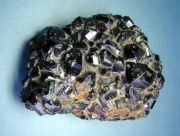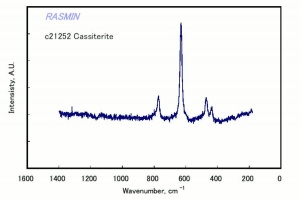Difference between revisions of "Cassiterite"
Jump to navigation
Jump to search
m (Text replace - "== Authority ==" to "== Sources Checked for Data in Record ==") |
|||
| (4 intermediate revisions by the same user not shown) | |||
| Line 1: | Line 1: | ||
| − | [[File:Cassiteriteemr1.jpg|thumb|Cassiterite (tin | + | [[File:Cassiteriteemr1.jpg|thumb|Cassiterite (tin dioxide)]] |
== Description == | == Description == | ||
| − | A hard, dense, brown to black mineral composed of [[ | + | A hard, dense, brown to black mineral composed of [[stannic oxide|Tin dioxide]]. Cassiterite is the principal ore of [[tin]]. Starting in the 15th century, cassiterite was mined in Saxony and Bohemia. Currently it is mined in southeast Asia (Myanmar, Thailand, Malaysia, Indonesia), Bolivia (Llallagua), Nigeria, Russia, England (Cornwall), and the U.S. (Virginia, Washington, California). Cassiterite has a dull metallic luster and can be transparent to opaque. It has occasionally been used as a gemstone. |
== Synonyms and Related Terms == | == Synonyms and Related Terms == | ||
| Line 10: | Line 10: | ||
[[[SliderGallery rightalign|cassiteriteRS.jpg~Raman]]] | [[[SliderGallery rightalign|cassiteriteRS.jpg~Raman]]] | ||
| − | == | + | ==Physical and Chemical Properties== |
| − | Tetragonal crystal system with prisms, pyramids or fibers. Good cleavage in two directions. | + | * Tetragonal crystal system with prisms, pyramids or fibers. |
| − | + | * Good cleavage in two directions. | |
| − | Fracture = uneven. Luster = adamantine to dull. Streak = white, gray or brown. | + | * Fracture = uneven. |
| − | + | * Luster = adamantine to dull. | |
| − | Insoluble in acids. | + | * Streak = white, gray or brown. |
| − | + | * Insoluble in acids. | |
| − | Pleochroism. High | + | * Pleochroism. High birefringence under crossed polars. Straight extinction. |
| + | * Fluorescence: Weak yellow in SW; white in LW | ||
{| class="wikitable" | {| class="wikitable" | ||
| Line 29: | Line 30: | ||
|- | |- | ||
! scope="row"| Density | ! scope="row"| Density | ||
| − | | 6.8-7.1 | + | | 6.8-7.1 g/ml |
|- | |- | ||
! scope="row"| Refractive Index | ! scope="row"| Refractive Index | ||
| Line 35: | Line 36: | ||
|} | |} | ||
| − | == | + | ==Resources and Citations== |
| − | + | * Database of Luminescent Minerals: [http://www.fluomin.org/uk/fiche.php?id=277 Cassiterite] | |
| − | Mineralogy Database: [http://www.webmineral.com/data/Cassiterite.shtml Cassiterite] | + | * Mineralogy Database: [http://www.webmineral.com/data/Cassiterite.shtml Cassiterite] |
| − | |||
| − | |||
| − | |||
* Nicholas Eastaugh, Valentine Walsh, Tracey Chaplin, Ruth Siddall, ''Pigment Compendium'', Elsevier Butterworth-Heinemann, Oxford, 2004 | * Nicholas Eastaugh, Valentine Walsh, Tracey Chaplin, Ruth Siddall, ''Pigment Compendium'', Elsevier Butterworth-Heinemann, Oxford, 2004 | ||
| − | |||
* Henry Hodges, ''Artifacts: An Introduction to Early Materials and Technology'', Ronald P. Frye, Kingston, Canada, 1988 | * Henry Hodges, ''Artifacts: An Introduction to Early Materials and Technology'', Ronald P. Frye, Kingston, Canada, 1988 | ||
| − | |||
* Robert Fournier, ''Illustrated Dictionary of Practical Pottery'', Chilton Book Company, Radnor, PA, 1992 | * Robert Fournier, ''Illustrated Dictionary of Practical Pottery'', Chilton Book Company, Radnor, PA, 1992 | ||
| − | + | * ''Encyclopedia Britannica'', http://www.britannica.com Comment: "cassiterite" [Accessed December 11, 2001]. | |
| − | * ''Encyclopedia Britannica'', http://www.britannica.com Comment: "cassiterite" | ||
| − | |||
* C.W.Chesterman, K.E.Lowe, ''Audubon Society Field Guide to North American Rocks and Minerals'', Alfred A. Knopf, New York, 1979 | * C.W.Chesterman, K.E.Lowe, ''Audubon Society Field Guide to North American Rocks and Minerals'', Alfred A. Knopf, New York, 1979 | ||
| − | + | * Wikipedia: [https://en.wikipedia.org/wiki/Cassiterite Cassiterite] (accessed Sept 2 2005 and May 2023) | |
| − | * Wikipedia | ||
| − | |||
* Richard S. Lewis, ''Hawley's Condensed Chemical Dictionary'', Van Nostrand Reinhold, New York, 10th ed., 1993 | * Richard S. Lewis, ''Hawley's Condensed Chemical Dictionary'', Van Nostrand Reinhold, New York, 10th ed., 1993 | ||
| − | |||
* ''Van Nostrand's Scientific Encyclopedia'', Douglas M. Considine (ed.), Van Nostrand Reinhold, New York, 1976 | * ''Van Nostrand's Scientific Encyclopedia'', Douglas M. Considine (ed.), Van Nostrand Reinhold, New York, 1976 | ||
| − | |||
* Random House, ''Webster's Encyclopedic Unabridged Dictionary of the English Language'', Grammercy Book, New York, 1997 | * Random House, ''Webster's Encyclopedic Unabridged Dictionary of the English Language'', Grammercy Book, New York, 1997 | ||
| − | |||
* ''The American Heritage Dictionary'' or ''Encarta'', via Microsoft Bookshelf 98, Microsoft Corp., 1998 | * ''The American Heritage Dictionary'' or ''Encarta'', via Microsoft Bookshelf 98, Microsoft Corp., 1998 | ||
Latest revision as of 13:47, 18 May 2023
Description
A hard, dense, brown to black mineral composed of Tin dioxide. Cassiterite is the principal ore of Tin. Starting in the 15th century, cassiterite was mined in Saxony and Bohemia. Currently it is mined in southeast Asia (Myanmar, Thailand, Malaysia, Indonesia), Bolivia (Llallagua), Nigeria, Russia, England (Cornwall), and the U.S. (Virginia, Washington, California). Cassiterite has a dull metallic luster and can be transparent to opaque. It has occasionally been used as a gemstone.
Synonyms and Related Terms
tinstone; tin stone; wood tin; stream tin; Zinnstein (Deut.); Kassiterit (Deut.); cassitérite (Fr.); casiterita (Esp.); cassiterite (Port.); cassiteriet (Ned.)
Physical and Chemical Properties
- Tetragonal crystal system with prisms, pyramids or fibers.
- Good cleavage in two directions.
- Fracture = uneven.
- Luster = adamantine to dull.
- Streak = white, gray or brown.
- Insoluble in acids.
- Pleochroism. High birefringence under crossed polars. Straight extinction.
- Fluorescence: Weak yellow in SW; white in LW
| Composition | SnO2 |
|---|---|
| Mohs Hardness | 6.0 - 7.0 |
| Density | 6.8-7.1 g/ml |
| Refractive Index | about 2.0 |
Resources and Citations
- Database of Luminescent Minerals: Cassiterite
- Mineralogy Database: Cassiterite
- Nicholas Eastaugh, Valentine Walsh, Tracey Chaplin, Ruth Siddall, Pigment Compendium, Elsevier Butterworth-Heinemann, Oxford, 2004
- Henry Hodges, Artifacts: An Introduction to Early Materials and Technology, Ronald P. Frye, Kingston, Canada, 1988
- Robert Fournier, Illustrated Dictionary of Practical Pottery, Chilton Book Company, Radnor, PA, 1992
- Encyclopedia Britannica, http://www.britannica.com Comment: "cassiterite" [Accessed December 11, 2001].
- C.W.Chesterman, K.E.Lowe, Audubon Society Field Guide to North American Rocks and Minerals, Alfred A. Knopf, New York, 1979
- Wikipedia: Cassiterite (accessed Sept 2 2005 and May 2023)
- Richard S. Lewis, Hawley's Condensed Chemical Dictionary, Van Nostrand Reinhold, New York, 10th ed., 1993
- Van Nostrand's Scientific Encyclopedia, Douglas M. Considine (ed.), Van Nostrand Reinhold, New York, 1976
- Random House, Webster's Encyclopedic Unabridged Dictionary of the English Language, Grammercy Book, New York, 1997
- The American Heritage Dictionary or Encarta, via Microsoft Bookshelf 98, Microsoft Corp., 1998

